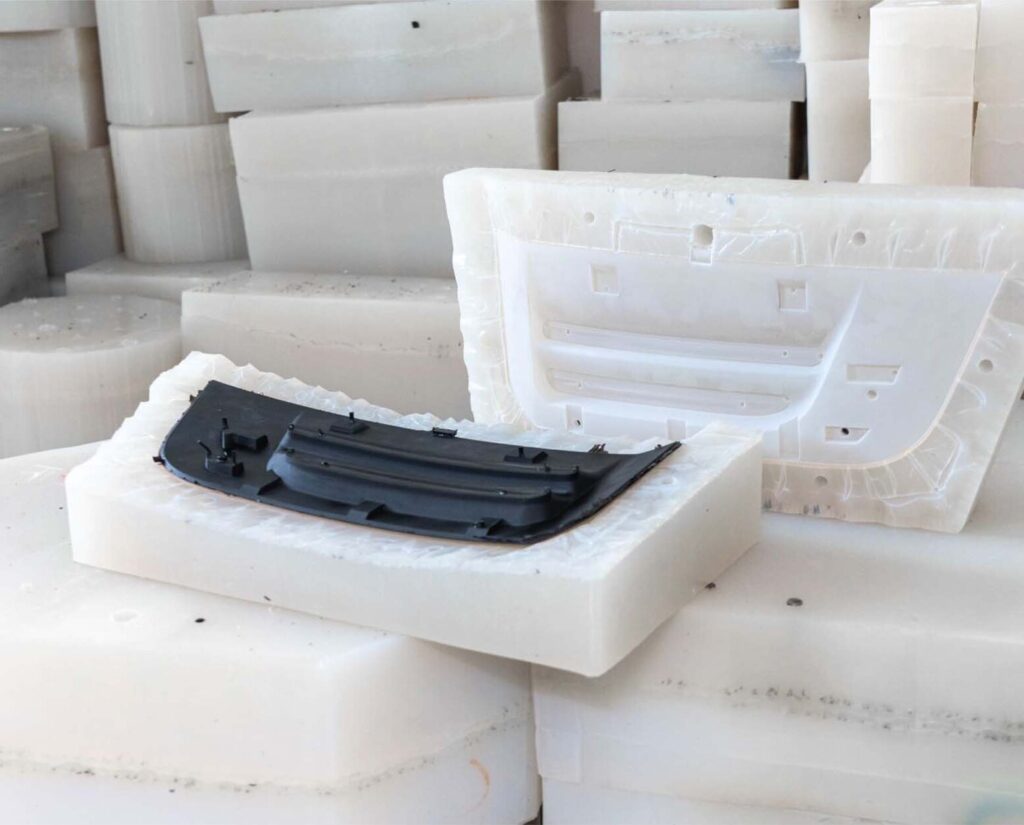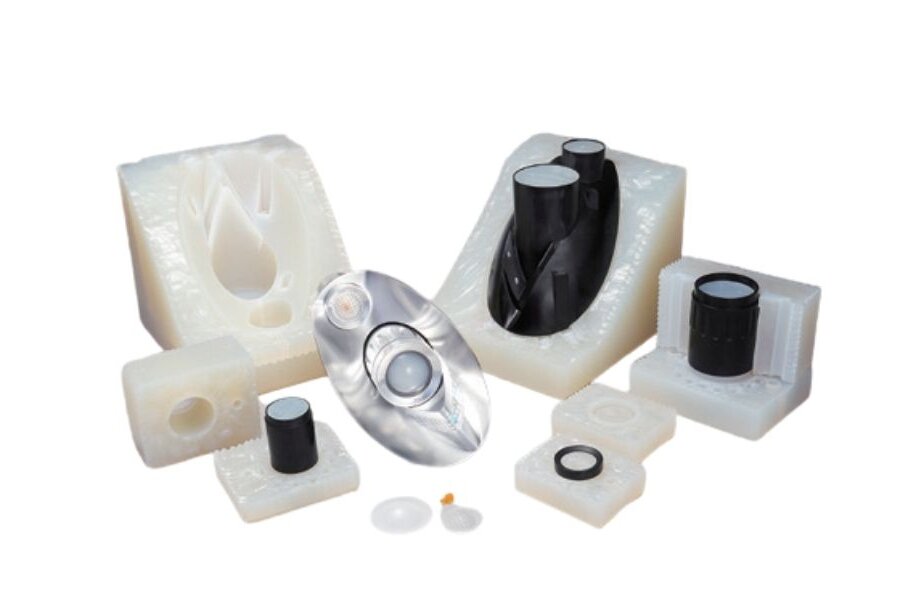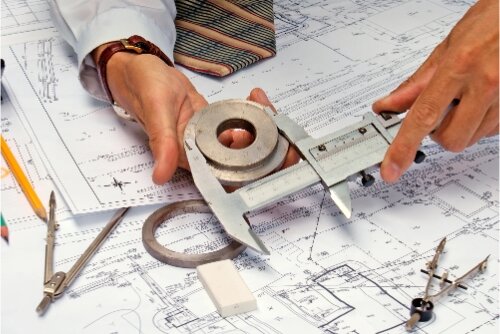يمكن أن يؤدي تصنيع النماذج الأولية بسرعة إلى وضع الجدول الزمني لتطوير منتجك أو كسره. يصطدم العديد من مطوري المنتجات بحائط مسدود عندما تثبت الطرق التقليدية مثل القولبة بالحقن أنها مكلفة للغاية وتستغرق وقتًا طويلاً لعمليات الإنتاج الصغيرة. يوفر الصب بالتفريغ حلاً دقيقًا وفعالاً من حيث التكلفة لإنشاء نماذج أولية عالية الجودة وإنتاج دفعات صغيرة.
لقد تطورت التكنولوجيا الكامنة وراء الصب بالتفريغ الهوائي بشكل كبير خلال العقد الماضي. ستفصل الأقسام التالية العملية بأكملها، بدءًا من إنشاء القالب وحتى إنتاج الجزء النهائي، مما يساعدك على تحديد ما إذا كانت هذه الطريقة تناسب مشروعك التالي.

ما هو الصب بالمكنسة الكهربائية؟
يصنع الصب بالتفريغ الهوائي أجزاء بلاستيكية باستخدام قالب سيليكون يوضع في حجرة تفريغ الهواء. تبدأ العملية بنموذج رئيسي، عادةً ما يكون مطبوعة ثلاثية الأبعاد أو التصنيع الآلي باستخدام الحاسب الآلي. نقوم بصب السيليكون السائل حول هذا النمط لإنشاء قالب مرن. بمجرد معالجته، نقوم بإزالة النمط تاركين تجويفاً دقيقاً.
تُنشئ هذه الطريقة نسخًا متماثلة مفصّلة من نمط رئيسي، مما يجعلها مثالية للنماذج الأولية وعمليات الإنتاج الصغيرة التي تتراوح بين 20 و50 وحدة. وتوفر هذه العملية تشطيبات سطحية ممتازة ودقة أبعاد ممتازة مع الحفاظ على تكاليف يمكن التحكم فيها.
كيف يعمل الصب بالتفريغ الهوائي؟
تتبع عملية الصب بالتفريغ الهوائي عملية منهجية تحول النمط الرئيسي إلى أجزاء متعددة متطابقة. وتتطلب هذه التقنية الاهتمام بالتفاصيل والتحكم الدقيق في كل مرحلة لإنتاج نتائج عالية الجودة. دعونا نفصل كل خطوة.
الخطوة 1: إنشاء نموذج ثلاثي الأبعاد
يبدأ كل مشروع بنموذج ثلاثي الأبعاد مفصّل. ويتطلب هذا المخطط الرقمي دراسة دقيقة لخصائص التصميم مثل سُمك الجدار وزوايا السحب وقوام السطح. يتحول النموذج إلى نمط رئيسي من خلال الطباعة ثلاثية الأبعاد أو التصنيع باستخدام الحاسب الآلي.
تشمل اعتبارات التصميم الشائعة ما يلي:
- الحد الأدنى لسُمك الجدار 0.8 مم
- زوايا السحب من 1-2 درجة
- الوضع الاستراتيجي للخطوط الفاصلة
- مواقع التنفيس المناسبة
الخطوة 2: صنع قالب السيليكون
تلتقط هذه المرحلة الحرجة كل تفاصيل النمط الرئيسي الخاص بك. تتطلب عملية إنشاء قالب السيليكون الدقة والصبر لضمان جودة النسخ المتماثلة.
يتم تركيب النمط الرئيسي داخل إطار الصب. يتدفق السيليكون السائل حوله تحت ظروف التفريغ. بعد 8-12 ساعة من المعالجة، يقوم الفنيون بقطع خطوط فاصلة بعناية لإنشاء قالب من جزأين.
العوامل الحاسمة لنجاح صناعة القالب:
- استخدام عامل الإطلاق السليم
- وضع النسيج والفتحات الاستراتيجية
- تحكم دقيق في درجة الحرارة
- بيئة عمل نظيفة
الخطوة 3: عملية الصب
تتضمن هذه المرحلة الإنتاج الفعلي للجزء. تعمل بيئة التفريغ على إزالة فقاعات الهواء التي يمكن أن تؤثر على جودة القِطع.
يقوم الفنيون بخلط راتنجات محددة وفقًا لنسب دقيقة. يصب الخليط في القالب داخل حجرة تفريغ الهواء. يقوم التفريغ بسحب الراتنج إلى كل تفاصيل تجويف القالب، مما يضمن النسخ المثالي.
معلمات العملية للمراقبة:
- نسب خلط الراتنج
- مستويات ضغط التفريغ
- درجة حرارة الصب
- لزوجة المادة
الخطوة 4: المعالجة وإزالة القوالب
تحول هذه المرحلة الراتنج السائل إلى أجزاء صلبة. تحدد ظروف المعالجة المناسبة جودة الجزء النهائي.
يتم معالجة الأجزاء في بيئات يتم التحكم في درجة حرارتها. وبمجرد أن تصبح صلبة، يقوم الفنيون المهرة بإزالتها بعناية من القالب. تتطلب هذه الخطوة خبرة لمنع تلف كل من الجزء والقالب.
عوامل المعالجة الحرجة:
- التحكم في درجة الحرارة
- مستويات الرطوبة
- مراقبة وقت الشفاء
- تقنيات إزالة القوالب السليمة
الخطوة 5: إعادة استخدام القالب
توفر قوالب السيليكون استخدامات متعددة قبل الاستبدال. العناية المناسبة تطيل عمر القالب وتحافظ على جودة القالب.
ينتج كل قالب عادةً 20-50 قطعة. يقوم الفنيون بفحص القوالب بين الدورات بحثًا عن التآكل أو التلف. تزيد الصيانة الدورية والمعالجة الدقيقة من عدد القوالب الناجحة إلى أقصى حد.
أفضل الممارسات لطول عمر العفن:
- إجراءات إزالة القوالب بعناية
- التنظيف المنتظم للعفن
- ظروف التخزين المناسبة
- فحص الجودة بين الاستخدامات
الصب بالمكنسة الكهربائية: الإيجابيات والسلبيات
تجلب العملية فوائد وقيودًا محددة تؤثر على قرارات المشروع. يجب أن تزن فرق الإنتاج هذه العوامل عند اختيار طريقة التصنيع الصحيحة.
مزايا
الفوائد من حيث التكلفة
- انخفاض تكاليف الأدوات مقارنةً بالقولبة بالحقن
- لا يوجد حد أدنى لكمية الطلبات المطلوبة
- وقت الاستجابة السريع للدفعات الصغيرة
- انخفاض تكاليف الإعداد وبدء التشغيل
حرية التصميم
- إنشاء أشكال هندسية معقدة بكل سهولة
- يسمح بالتخفيضات في التصميم
- إعادة إنتاج تفاصيل السطح الدقيقة
- يدعم خيارات المواد المختلفة
- يسمح بإجراء تعديلات سريعة على التصميم
ميزات الجودة
- يوفر لمسة نهائية ممتازة للسطح
- يحافظ على دقة الأبعاد الدقيقة
- إنتاج أجزاء خالية من الفراغات
- إنشاء أجزاء مشابهة لجودة الإنتاج
- تمكين الاختبار الوظيفي
سلبيات
قيود الإنتاج
- تدوم القوالب عادةً من 20-50 قطعة
- ارتفاع تكاليف الوحدة للكميات الكبيرة
- معدل إنتاج أبطأ من القولبة بالحقن
- قيود الحجم على الأجزاء النهائية
القيود المادية
- خيارات مواد أقل من القولبة بالحقن
- قد تختلف خصائص المواد عن الإنتاج
- تمثل مطابقة الألوان تحديات
- يمكن أن يختلف تشطيب السطح بين الدفعات
التحديات التقنية
- تتطلب موظفين فنيين مهرة
- يظهر حساسية للتغيرات في درجات الحرارة
- يعاني من تآكل العفن بمرور الوقت
- قد تظهر اختلافات طفيفة بين الأجزاء
- يتطلب مراقبة دقيقة للجودة
- يحتاج إلى بيئة مضبوطة
المواد المستخدمة في الصب بالتفريغ
يشكل اختيار المواد أداء المنتج وخصائصه. يجلب كل نوع من أنواع الراتنجات خصائص مميزة تتناسب مع احتياجات الاستخدام المحددة. ويحدد الاختيار الصحيح للمواد نجاح المشروع.
الراتنجات الشبيهة بـ ABS
تحاكي هذه الراتنجات خصائص بلاستيك ABS التقليدي. وهي توفر مقاومة ممتازة للصدمات وجودة تشطيبات سطحية ممتازة للنماذج الأولية الوظيفية.
الخصائص التي تحدد الراتنجات الشبيهة بـ ABS:
- صلابة الشاطئ D: 75-85
- مقاومة الحرارة: 75-85 درجة مئوية
- قوة الشد: 45-55 ميجا باسكال
- خيارات الألوان: متعدد
نايلون مملوء بالزجاج مثل النايلون
تضيف المواد المملوءة بالزجاج القوة والثبات. تعمل هذه الراتنجات بشكل جيد مع الأجزاء الهيكلية التي تحتاج إلى صلابة إضافية.
تشمل الخصائص الرئيسية ما يلي:
- صلابة معززة
- مقاومة أفضل للحرارة
- الحد الأدنى من الالتواء
- مقاومة فائقة للتآكل
المطاط الصناعي المرن TPE-مثل
تصنع هذه المواد أجزاء مرنة تشبه المطاط. وهي تخدم التطبيقات التي تتطلب ليونة ومرونة.
المواصفات النموذجية:
- صلابة الشاطئ A: 40-90
- الاستطالة 350-450%
- قوة التمزق: جيد
- مجموعة الضغط: منخفضة
مثل الكمبيوتر الشخصي
توفر الراتنجات الشبيهة بالكمبيوتر الشخصي شفافية وقوة تأثير. وهي تتفوق في التطبيقات التي تحتاج إلى الوضوح والمتانة.
الميزات القياسية:
- مقاومة عالية للصدمات
- مقاومة جيدة للحرارة
- الوضوح البصري
- ثبات الأشعة فوق البنفسجية
راتنجات شفافة
تسمح المواد الشفافة بالفحص البصري للميزات الداخلية. تصنع هذه الراتنجات أجزاء ذات وضوح بصري.
تستفيد التطبيقات من:
- 90% نقل الضوء 90%
- اصفرار منخفض
- تشطيب سطح أملس
- ثبات أبعاد جيد
راتنجات عالية التأثير
تتحمل هذه المواد الإجهاد البدني الشديد. فهي تصنع أجزاء متينة للاستخدامات الصعبة.
خصائص الأداء:
- قوة تأثير ممتازة
- معامل الانثناء العالي
- مقاومة جيدة للمواد الكيميائية
- ثبات درجة الحرارة
| نوع المادة | الخصائص الرئيسية | الصلابة (شور) | مقاومة الحرارة (درجة مئوية) | التطبيقات المشتركة |
|---|---|---|---|---|
| ABS-Like | مقاومة عالية للصدمات، تشطيب جيد للسطح، ألوان متعددة | D 75-85 | 75-85 | المنتجات الاستهلاكية، العلب الإلكترونية، الأجزاء الميكانيكية |
| نايلون مملوء بالزجاج مثل النايلون | صلابة عالية، حد أدنى من الالتواء، مقاومة للاهتراء | D 80-85 | 120-130 | المكونات الهيكلية، الأجزاء الحاملة، النماذج الأولية الوظيفية |
| TPE-مثل | مرونة، مرونة عالية، مرونة عالية، قوة تمزق جيدة | A 40-90 | 70-80 | مقابض ومقابض، وموانع تسرب وحشيات، وأجزاء ناعمة الملمس |
| مثل الكمبيوتر الشخصي | شفافية عالية، مقاومة للصدمات، مقاومة للأشعة فوق البنفسجية | D 80-85 | 110-120 | أغطية الإضاءة، ونوافذ العرض، والمكونات البصرية |
| راتنجات شفافة | 90% شفافية، اصفرار منخفض، لمسة نهائية ناعمة | D 75-80 | 75-85 | تحليل تدفق السوائل، نماذج العرض، نماذج العرض، النماذج الأولية المرئية |
| عالية التأثير | متانة فائقة، ومقاومة للمواد الكيميائية، وثبات في درجة الحرارة | D 85-90 | 100-110 | اختبار النماذج، الأجزاء الوظيفية، المكونات عالية الإجهاد |
الصب بالتفريغ الهوائي مقابل تقنيات التصنيع الأخرى
تتميز طرق التصنيع بخصائص مميزة تجعلها مناسبة لسيناريوهات الإنتاج المختلفة. يقارن هذا القسم بين الصب بالتفريغ الهوائي والتقنيات القياسية الأخرى لمساعدتك على اتخاذ قرارات مستنيرة بشأن المشروع.
مقارنة مع القولبة بالحقن
يوفر الصب بالتفريغ الهوائي تكاليف أدوات أقل وأوقات تسليم أسرع من القولبة بالحقن. وفي حين أن القولبة بالحقن تتطلب قوالب معدنية باهظة الثمن تكلف عشرات الآلاف من الدولارات، فإن الصب بالتفريغ الهوائي يستخدم قوالب سيليكون بسعر زهيد.
ومع ذلك, القولبة بالحقن يفوز بالإنتاج بكميات كبيرة. بمجرد تصنيع القالب المعدني، يمكن إنتاج الأجزاء بسرعة وبتكاليف منخفضة للوحدة. وعادةً ما يستغرق وقت دورة القولبة بالحقن ثواني، بينما يستغرق الصب بالتفريغ ساعات لكل جزء.
الصب بالفراغ مقابل الطباعة ثلاثية الأبعاد
تتفوق الطباعة ثلاثية الأبعاد في إنشاء نماذج أولية لمرة واحدة ذات أشكال هندسية معقدة، ولا تتطلب أدوات أو قوالب. تسمح العملية بتكرار التصميم بسرعة وبدء الإنتاج الفوري. ومع ذلك، فإن تشطيب السطح وخصائص المواد غالباً ما تكون أقل من الأجزاء المصبوبة بالتفريغ.
ينتج الصب بالتفريغ أجزاء ذات جودة سطح فائقة وخصائص ميكانيكية تتطابق بشكل كبير مع المنتجات المصبوبة بالحقن. على الرغم من أنه يتطلب صنع قالب أولاً، إلا أن الصب بالتفريغ يصبح أكثر فعالية من حيث التكلفة من الطباعة ثلاثية الأبعاد عند إنتاج أجزاء متعددة متطابقة.
الصب بالتفريغ الهوائي مقابل الصب بالطرد المركزي
يستخدم الصب بالطرد المركزي قوة دورانية لتوزيع المواد، مما يجعلها ممتازة للأجزاء المتماثلة مثل الأنابيب والحلقات. تعمل هذه الطريقة بشكل جيد مع المعادن وتنتج أجزاء كثيفة بسُمك جدار متناسق في أشكال أسطوانية.
وعلى النقيض من ذلك، يتعامل الصب بالتفريغ الهوائي مع كل من الأشكال الهندسية المتماثلة وغير المتماثلة بنفس الدقة. وهو يعمل في المقام الأول مع البلاستيك والراتنجات، مما يوفر إعادة إنتاج تفاصيل أفضل وتشطيب أفضل للسطح. وتمنع بيئة التفريغ احتباس الهواء، مما يؤدي إلى عيوب أقل من الصب بالطرد المركزي الذي ينطوي على إمكانية فصل المواد.
التطبيقات الحرجة للصب بالتفريغ الهوائي
تستفيد الصناعات المختلفة من عملية الصب بالتفريغ لتلبية احتياجات الإنتاج المحددة. تتكيف هذه العملية متعددة الاستخدامات مع مختلف تحديات التصنيع ومتطلبات المنتج.
تطوير النموذج الأولي
تتفوق العملية في إنشاء نماذج أولية وظيفية. وتستخدم فرق التصميم هذه النماذج لاختبار المنتجات والتحقق من صحتها وتنقيحها قبل الإنتاج بكميات كبيرة.
أمثلة على حالات استخدام النماذج الأولية
- اختبار الأجهزة الطبية
- التحقق من صحة المنتج الاستهلاكي
- الدراسات المريحة
- فحوصات الملاءمة والتشطيب
- التحقق من التجميع
تشغيلات الإنتاج منخفضة الحجم
يلبي إنتاج الدفعات الصغيرة متطلبات السوق دون استثمارات كبيرة في المخزون. يناسب هذا النهج المنتجات المتخصصة ومراحل اختبار السوق.
الصناعات التي تعتمد على الإنتاج منخفض الحجم
- مكونات الطيران والفضاء
- قطع غيار الماكينات المخصصة
- السلع الفاخرة
- منتجات الإصدار الخاص
- قطع غيار
الأجزاء المخصصة والمعقدة
تتعامل العملية مع التصميمات المعقدة التي تتحدى الطرق التقليدية. يقوم المصنّعون بإنشاء أجزاء مفصّلة دون أي تنازلات.
الصب بالتفريغ الهوائي للأجزاء عالية الدقة
- الأدوات الطبية
- المعدات العلمية
- المكونات البصرية
- علب المستشعرات
- معدات الاختبار

اختيار خدمة الصب بالمكنسة الكهربائية المناسبة
يؤثر اختيار شريك التصنيع المثالي على نجاح المشروع. تساعد عملية التقييم الشاملة على تأمين دعم إنتاج موثوق به لاحتياجاتك الخاصة.
الخبرة الفنية
- قدرة الدعم الهندسي
- معرفة اختيار المواد
- طرق التحكم في العمليات
- أنظمة فحص الجودة
- مهارات تحسين التصميم
المعدات والمرافق
- غرف تفريغ الهواء الحديثة
- أنظمة التحكم في درجة الحرارة
- بيئات الغرف النظيفة
- معدات مناولة المواد
- أدوات مراقبة الجودة
معايير الجودة
- شهادة الأيزو 9001
- إجراءات مراقبة الجودة
- معدات الفحص
- أنظمة التوثيق
- طرق التحقق من صحة العملية
قدرات الإنتاج
- سعة حجم الجزء
- الناتج الشهري المحتمل
- خيارات المواد المتاحة
- مستويات تشطيب السطح
- القدرة على مطابقة الألوان
ميزات الخدمة
- استجابة سريعة للاقتباس
- ملاحظات التصميم
- إدارة المشاريع
- أنظمة الاتصالات
- موثوقية التسليم
خاتمة
يُعد الصب بالتفريغ بالتفريغ حلاً فعالاً لمطوري المنتجات والمصنعين الذين يحتاجون إلى نماذج أولية عالية الجودة وعمليات إنتاج صغيرة. تعمل هذه الطريقة على سد الفجوة بين النماذج الأولية لمرة واحدة والإنتاج بكميات كبيرة، مما يوفر توازنًا بين الجودة والتكلفة والمرونة التي تناسب العديد من احتياجات التصنيع الحديثة.
تستمر التكنولوجيا في التقدم مع المواد الجديدة والعمليات المحسنة. من الأجهزة الطبية إلى المنتجات الاستهلاكية، تثبت تقنية الصب بالتفريغ قيمتها من خلال أوقات التسليم السريعة وحرية التصميم والإنتاج الفعال من حيث التكلفة للدفعات الصغيرة.
الأسئلة الشائعة
ما المدة التي يستغرقها الصب بالتفريغ الهوائي؟
يستغرق مشروع الصب بالتفريغ الهوائي النموذجي من 5 إلى 7 أيام من استلام النموذج الرئيسي إلى تسليم الأجزاء النهائية. يحتاج إنشاء قالب السيليكون من 24 إلى 48 ساعة، بينما تتطلب كل دورة صب من 4 إلى 8 ساعات، حسب تعقيد الجزء وحجمه.
ما هي أنواع الراتنجات الأفضل للصب بالتفريغ الهوائي؟
تعمل راتنجات البولي يوريثان بشكل أفضل في الصب بالتفريغ الهوائي نظرًا لخصائص التدفق الممتازة ومجموعة واسعة من الخصائص الميكانيكية. يمكن أن تحاكي هذه الراتنجات مواد الإنتاج المختلفة مثل ABS، والكمبيوتر الشخصي، وPP، مما يجعلها مثالية للنماذج الأولية والاختبارات الوظيفية.
هل يمكن استخدام الصب بالتفريغ الهوائي للإنتاج على نطاق واسع؟
يعمل الصب بالتفريغ الهوائي بشكل أفضل لعمليات الإنتاج الصغيرة من 20-50 قطعة لكل قالب. بالنسبة للكميات الأكبر، يصبح القولبة بالحقن أكثر فعالية من حيث التكلفة. تناسب هذه العملية تطوير النماذج الأولية والإنتاج على دفعات صغيرة بدلاً من التصنيع بكميات كبيرة.
هل الصب بالمكنسة الكهربائية مكلف؟
ونظرًا لانخفاض نفقات الأدوات، فإن التكلفة الأولية للصب بالتفريغ أقل من تكلفة القولبة بالحقن. وفي حين أن تكلفة القطعة الواحدة أعلى من تكلفة طرق الإنتاج الضخم، فإن التكلفة الإجمالية للمشروع تظل تنافسية بالنسبة للكميات الصغيرة التي تقل عن 50 وحدة.
ما هي التكاليف النموذجية المرتبطة بالصب بالتفريغ الهوائي؟
تبدأ أسعار القِطع الأساسية المصبوبة بالتفريغ من $50-100 لكل وحدة، وتختلف حسب الحجم والتعقيد واختيار المواد. وتتراوح تكاليف القوالب بين $500-1500، ولكن هذا الاستثمار يتوزع على أجزاء متعددة. وعادةً ما تتراوح التكلفة الإجمالية للمشروع بين $2000-5000 تيرابايت إلى 5000 تيرابايت لعمليات الإنتاج الصغيرة.
مهلا، أنا كيفن لي

على مدى السنوات العشر الماضية، كنت منغمسًا في أشكال مختلفة من تصنيع الصفائح المعدنية، وشاركت رؤى رائعة هنا من تجاربي عبر ورش العمل المتنوعة.
ابقى على تواصل

كيفن لي
لدي أكثر من عشر سنوات من الخبرة المهنية في تصنيع الصفائح المعدنية، وتخصصت في القطع بالليزر، والثني، واللحام، وتقنيات معالجة الأسطح. كمدير فني في شنغن، أنا ملتزم بحل تحديات التصنيع المعقدة ودفع الابتكار والجودة في كل مشروع.




